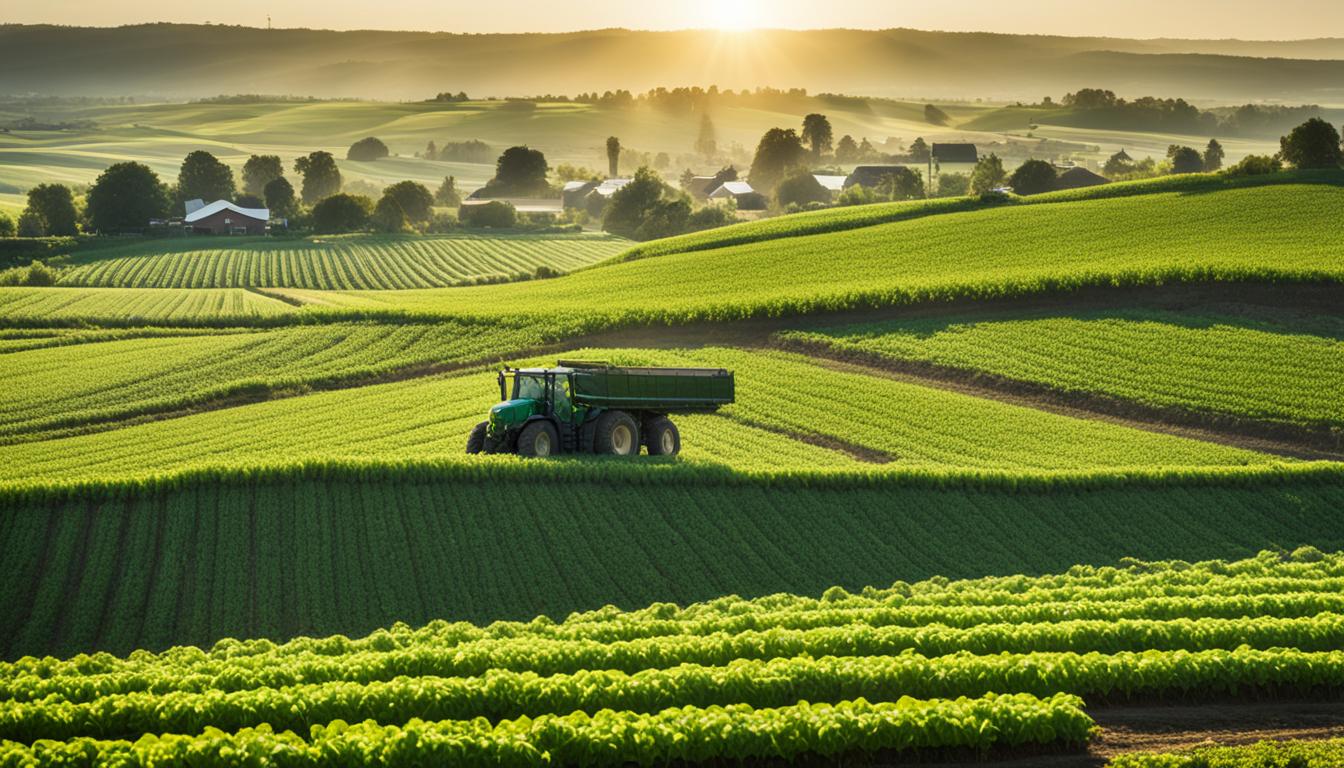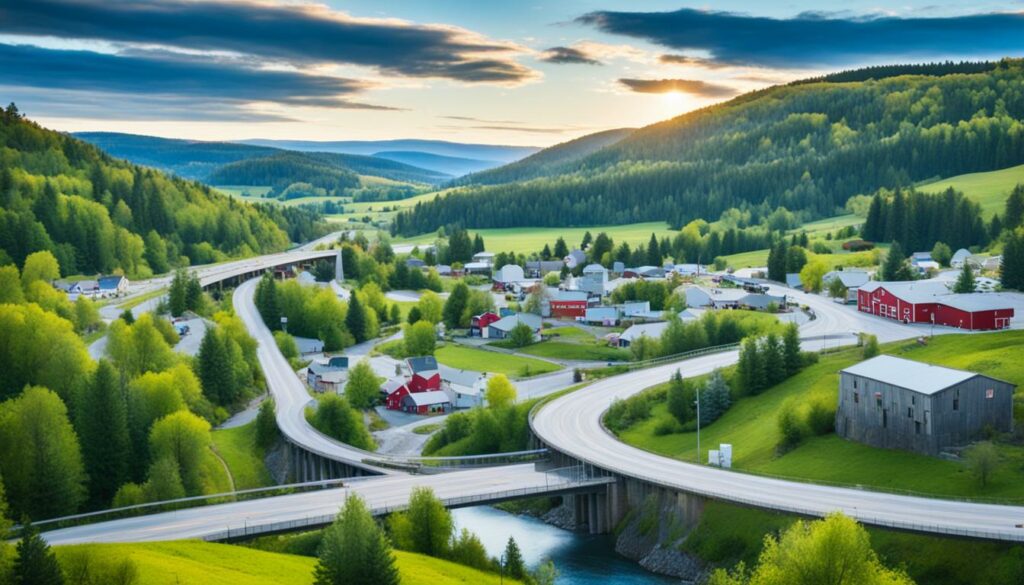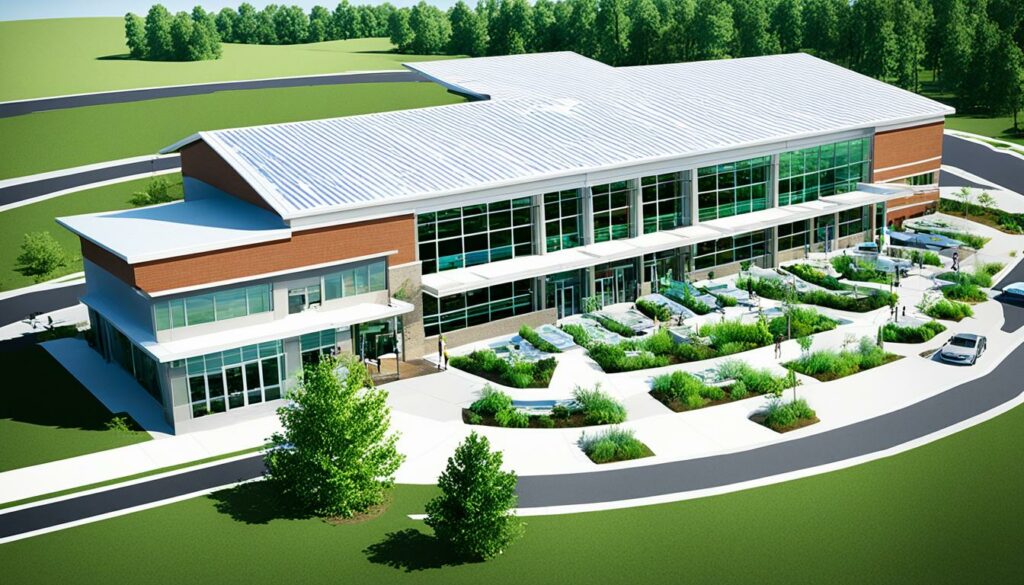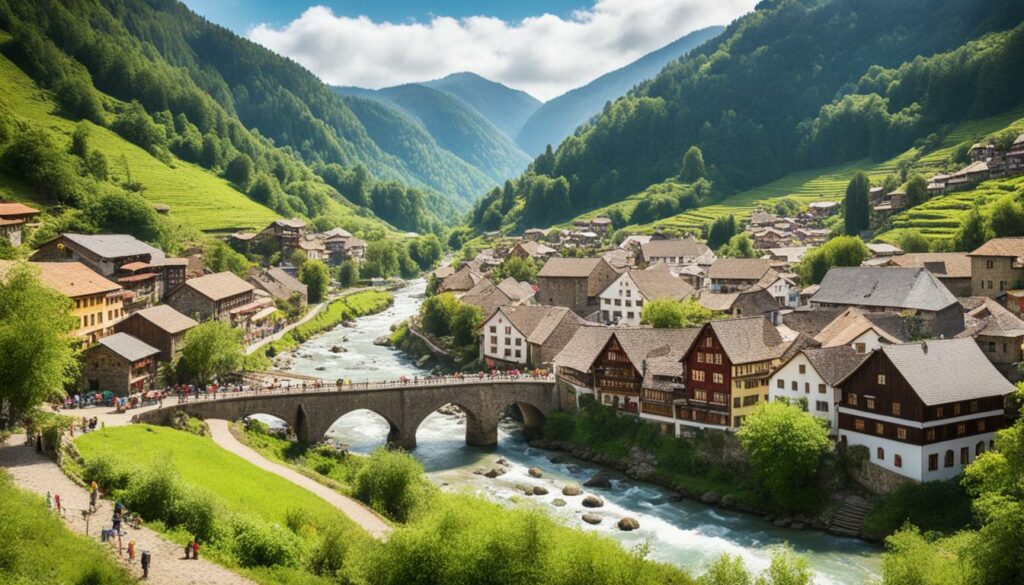Menu

Did you know that nearly 65 percent of all interstate highway miles are built through rural areas? Also, about 70 percent of Federal-aid highway miles cross these regions. These facts show how rural parts of the US are both vast and vital.
This large area is home to around 50 million Americans. It boasts more than farming, with its varied industries. Rural America includes everything from rocky mountains to lush plains. It’s a mix of different cultures and many chances for people.
Yet, rural economies face challenges like lower incomes and high poverty. Education and health issues can also be bigger problems here than in cities. To tackle these, the Federal Government supports rural business growth. It wants to create strong and lasting rural communities.
This aid is aimed at building up the economy and life in rural places. That way, they can be key parts of the country’s development. It’s all about making sure no area is left behind as the nation moves forward.
Approximately 50 million Americans live in rural parts of the United States. These places are the heart of the country’s economy. They’re not just farming anymore but are also in manufacturing, services, and trade. This shift underlines the importance of growing these economies. But, rural areas face issues like less income and more deaths. Tackling these challenges with new jobs and helping businesses is key.
Rural economies have always been about farming but now do much more. They include manufacturing, services, and local and global trade. Moving beyond farming has made these areas economically stronger. It’s vital to remember this change in planning how to help rural communities grow.
Growing rural economies is crucial for both local people and the nation. It helps bridge gaps in wealth, education, and health between cities and the countryside. The US government actively works on these issues, aiming to boost jobs and help businesses in rural areas. Their support through funds and programs improves life across rural America.
The American Recovery and Reinvestment Act of 2009 included $787 billion in total funding, raising employment by 2.2 million to 2.8 million jobs due to substantial outlays and tax relief.
Investing in rural schools, clean energy, and healthcare is making a big difference. Alongside government support, teamwork at all levels is improving rural living standards. This joint effort is key to lasting economic and social growth in the countryside.
Rural America is changing fast. While it used to depend mainly on farming, things are different now. But, compared to cities, these places still have big challenges. They deal with lower earnings, more poverty, and lots of older people. These issues make it harder for rural areas to stay strong.

Jobs are now spread across many types of work, not just farming. Even with this change, fewer people in rural areas go to university. They often need help from public health services. Families outside cities also spend a lot more of their money on health insurance. This makes their financial situation even tougher.
Improving rural infrastructure is key to fixing these problems. The American Recovery and Reinvestment Act of 2009 brought a lot of money for this. It helped make water and internet better, especially in Tribal lands. Over 247,000 homes now have better internet. This keeps these areas up to date with technology.
The Biden-Harris Administration cares a lot about rural places. They started the Rural Innovators Initiative to help. They’re giving $150 million to support farmers who help the climate. They’re also setting aside $4.1 billion for better transport in rural areas. These efforts are important for rural America to grow and do well, both economically and socially.
| Key Investments | Amount |
|---|---|
| High-Speed Internet Access | $65 billion |
| Water and Wastewater Infrastructure | $50 billion |
| Wildfire Defense Projects | $439 million |
| Rural Area Formula Grants | $4.1 billion |
| Clean Energy Projects | $9.7 billion |
Government help for rural economies is key. Through many federal aid schemes and local government actions, rural areas grow. This creates a path for steady economic advancement.
US government has many plans to boost rural places. They help with better roads, more internet access, and economic strength. The Broadband Equity, Access, and Deployment Program, for example, has $42,450,000,000 to aid broad projects.
The Middle Mile Grants Program, with $1,000,000,000, makes internet access cheaper. This helps people in places with little service get online. It’s all about making life better for everyone.
There are also grants for digital equity, like the Digital Equity Grants worth $2,750,000,000. And the Tribal Broadband Connectivity Program gives another $250,000,000. These programmes are meant to lessen the gap in digital access. They help with remote learning and health services to make them available to all.
Laws on rural development are very important. The Bipartisan Infrastructure Law puts $2 billion into improving rural roads. It helps fix the 13.1% of rural roads that are in poor shape.
There’s also a big $7.5 billion RAISE grant and $66 billion for passenger and freight trains. These funds go into making travel easier and more efficient in rural areas. This is great for businesses and people living in the countryside.
Local governments are critical for rural growth. They make federal initiatives work for their local needs. They manage money for projects that help with roads, schools, and businesses. This way, help comes right where it’s needed.
Working closely with locals, authorities tailor plans to build a stronger economy. They support new businesses and improve life for all. This shows how important local governments are for rural success in America.
Investing in rural infrastructure is vital for growing the economy across rural America. It helps link rural areas to the wider market. A large portion of highways, like 65% of the interstates, goes through these places showing the importance of this support.

Farmers need good roads to get their products to market, often travelling over 1,500 miles. Projects like the Rural Utilities Service’s work on electric and water systems from 2002 to 2009 show how this help adds up.
Infrastructure spending boosts the economy and prevents rural areas from falling behind. Funding has provided clean water and electricity to many places, with 47 projects helping over a million people. Broadband projects have also connected more rural areas, aiding in economic growth.
In Tennessee, the Caney Fork Electric Cooperative is bringing power to 3,000 new users and upgrading 253 miles of power lines. In South Dakota, the Rosebud Electric Cooperative is doing a similar project, helping over 400 people. These examples show how investing strategically in infrastructure can pay off.
| Project | Location | Impact |
|---|---|---|
| Water Main Replacement | Champlain, New York | Expanded access to clean water for residents |
| Infrastructure Renewal | Hyannis, Nebraska | Improved water quality for nearly 150 residents |
| Electric Line Improvement | Tennessee | Connection of nearly 3,000 consumers |
| Power Line Development | South Dakota | Connection and improvement for over 400 people |
Making employment opportunities in rural areas better is key to fighting poverty and boosting the economy. Places once only about farming now have jobs in making things, green energy, and welcoming visitors. It’s clear that many areas outside cities are losing people of working age. This problem has been growing since 1900. Rural places also have more people on disability benefits than urban areas.
Governments are stepping in to help, like putting up to $350 million in SBA money for small rural firms. They’re also spreading job info at 2,800 USDA local offices all over the country. This wider effort aims to bridge the gap in rural jobs.
How workers in the countryside do and what they own makes a big difference. For example, having richer soil can boost how much money rural businesses make by 11%. So, it’s important to help people own and work on better land.
Helping with tech and roads in rural areas is also really needed. For example, putting money into health IT lets rural hospitals hire more people. This, in turn, creates better jobs that people want to do.
Rural areas need an educational boost, too. In 2000, city folks were 10-15% more likely to have been to college. Now, new training and support from investors are helping change this. By focusing on these areas, we can make our communities stronger and richer.
Encouraging rural entrepreneurship is key to boost the economy. The Biden-Harris Administration supports this through USDA Rural Development. They offer loans and grants to help start businesses in rural areas.

This help is varied, from improving roads and internet access to helping businesses grow. Rural entrepreneurs get financial aid and support from the USDA and other government bodies for their ventures.
The USDA provides tools to get more money for rural business owners. They help set up places for new businesses, make farm products better, and find new markets online. They also cut energy bills and connect you to healthcare and job training.
Businesses in the countryside can also get money from different places, not just big investors. Special groups, like Community Development Financial Institutions (CDFIs), make it easier for rural businesses to get the money they need.
Many businesses have succeeded with the USDA’s help. Owners say these programs were critical for starting or growing their businesses. Their stories show how important this support is.
Some businesses grow big and create many jobs. This is especially true in areas with few job opportunities. Just a couple of these big businesses in small towns can lower unemployment a lot.
Even with challenges like finding skilled people, rural entrepreneurs can still succeed. Joining with experienced mentors and investors helps a lot. Having mentors and support online can also make a big difference.
Supporting rural entrepreneurs needs a group effort. It involves local people, better roads and schools, and more chances to get funds for businesses.
It’s crucial to build sustainable rural communities for their long-term strength. By adopting sustainable practices, these areas gain environmental, social, and economic benefits. This helps make them strong and united in the national scene.
Long-term rural community resilience begins with environmental sustainability. Key steps include using renewable energy, sustainable farming, and protecting natural resources. Randolph County’s Housing Authority is a good example. They’ve received a grant to preserve farmland, improve bus services, and make it easier for people to walk and cycle. All this is done while protecting the environment.
Sustainable development brings big social and economic wins for rural areas. Since 2009, the Partnership for Sustainable Communities has used federal policies to boost community efforts. This includes better transport, affordable housing, and stronger economies. Also, sustainable farming has educated many young people and officials in useful skills and farming methods. This has created jobs and helped local areas grow.
Moving towards a green economy is vital too. By 2050, it could bring over 24 million new jobs. This would offer lasting work, especially in the food and agriculture sectors. Different federal organisations and partnerships are helping with this shift. They invest in things like better education, more jobs, and improved infrastructure in rural places.
The table below outlines key investments and what they aim to achieve in rural areas:
| Initiative | Investment | Impact |
|---|---|---|
| Regional Planning Grants | $28 million | Enhanced regional sustainability plans |
| Community Challenge Planning Grants | $15 million | Improved community planning and infrastructure |
| Agricultural Training Programs | Not specified | Increased youth employment and financial literacy |
| Green Economy Transition | Federal investments | 24 million full-time jobs by 2050 |
These targeted efforts underscore sustainable development’s importance in rural regions. They show a broad approach that boosts resilience while driving economic stability and progress.
Agriculture is vital in the economy of rural areas, even with changes. It is key in keeping these regions stable. In places where over 50% of people work in agriculture, its decline could lead to social and political troubles. So, it’s crucial to support farming for area stability.

Farming supports many other businesses and services. It’s the backbone of countless activities, from supplying goods to processing them. For places with fewer people, farming helps keep the economy going. Supporting farmers through training, research, and land reforms is essential.
| Industry | Contribution to GDP (2023) | Employment (2022) |
|---|---|---|
| Agriculture, food, and related industries | $1.530 trillion (5.6% of GDP) | 22.1 million jobs (10.4% of total U.S. employment) |
| Direct on-farm employment | $203.5 billion (0.7% of GDP) | 2.6 million jobs (1.2% of U.S. employment) |
| Food services, eating, and drinking places | N/A | 12.7 million jobs |
| Food and beverage stores | N/A | 3.3 million jobs |
Organic farming is gaining popularity, leading to higher prices. This shows the important link between farming, jobs, and economic growth. Also, government spending on food and nutrition programs has increased by 48% over nine years, showing agriculture’s impact.
It’s vital to diversify rural economies to address economic disparities and boost areas left behind. Moving beyond just farming opens up new economic paths, bringing more stability to rural America.
Rural economies used to rely mainly on farming. But now, jobs in areas like farming, making things, and mining are less than 25% of the total jobs because of technology. So, it’s important to grow other types of jobs. For example, there’s been a 7% job growth in rural places, helped by jobs in different sectors.
The knowledge economy is key, as it offers more education and ways to get money. It can bring jobs that help people move up in society, making the economy fairer.
New industries like renewable energy, tech, and tourism offer a big chance for economic betterment. But, rural areas need more help to join these fields completely. Things like wrong location choices, racism, and class division make it harder for them.
Also, jobs for Black and Native people in rural places have only gone up by 3.4% and 3.3%. This shows we urgently need to invest and work to make rural economies more diverse.
Creating jobs is important for rural community health. It helps schools, hospitals, small companies, and culture spots. Adding new industries helps rural areas fight their economic problems from many sides.
“Approximately 80% of counties with long-term persistent poverty are rural, with around 25% of those counties having a higher representation of people of color.”
Sectors like renewable energy, manufacturing, tech, and tourism are strong opportunities. By focusing on these new rural industries, we can build a sturdy and varied economy.
Improving rural life starts with closing the education gap and better healthcare. This helps the rural economy and people’s lives. It’s about making education and health services accessible, affordable, and top-notch. This strengthens rural communities.
To improve education in rural areas, we need to spend big. The Recovery Act is putting $7 billion into this. It’s also using $280 million for new schools on Indian lands. This money aims to give rural students the same education chances as those in cities.
In rural places, healthcare is hard to keep up because there are fewer people. The 2011 budget plans to spend $2.5 billion on health centres to improve care. And thanks to the Affordable Care Act, more families in need can get health insurance. It helps up to 400 percent of the Federal poverty level.

The Bipartisan Infrastructure Law is investing $50 billion in better water and sanitation. This will ensure safer water and sanitation. The Recovery Act is also helping with $90 billion more for Medicaid between 2009 and 2019, thanks to better state rates.
| Funding Source | Purpose | Amount |
|---|---|---|
| Recovery Act | Education in Rural Areas | $7 billion |
| Recovery Act | School Construction on Bureau of Indian Affairs Lands | $280 million |
| Recovery Act | Accelarating Adoption of Health Information Technology | $26 billion |
| Bipartisan Infrastructure Law | Water and Wastewater Infrastructure | $50 billion |
By heavily investing in rural education and healthcare, we aim for a brighter, inclusive future for rural Americans. This investment in people’s well-being sparks positive, long-term changes in rural societies.
Small businesses are vital for rural areas, driving local growth and new ideas. The USDA and SBA are teaming up to help these communities. They want to invest more in small and overlooked areas. This effort aims to create more chances for those in rural areas.
The Biden-Harris team is focusing on helping rural small businesses. They have put over $671 million into rural infrastructure. This will help businesses grow. The USDA also gave $3.9 billion to bring better internet to over 622,000 people. Having good internet means rural businesses can compete better.
Aiding them, federal programs offer shared training, help, and advice. These are essential for rural entrepreneurs. The USDA and SBA teams are working together to help more. They aim to assist those facing social disadvantages. Such teamwork is key for the success of rural businesses.
The government’s help also reaches agricultural businesses. They are supporting these businesses to sell their products worldwide. For example, a grant in West Virginia is saving a lot of energy, like powering 10 homes. A loan in Maine supports small entrepreneurs. This shows the wide range of support available.
| State | Program | Impact |
|---|---|---|
| Northeast | Loan and Grant Funding | $23.4 million to bolster businesses, reduce energy use, and create economic opportunities |
| West Virginia | Rural Energy for America Program Grant | 128,641 kWh saved per year, powering 10 homes |
| Maine | Rural Microentrepreneurial Assistance Program Loan | Supports microentrepreneurs in multiple counties |
| New Hampshire | Hydroelectric Facilities Ownership | Produces 12,968,000 kWh annually |
| Vermont | Rural Microentrepreneurial Assistance Program Loan | $350,000 to support small businesses |
| Pennsylvania | Solar Photovoltaic System | Generates 1,831,000 kWh per year, enough for 168 homes |
| Maryland | Business & Industry Loan Guarantee | $10,000,000 to increase unmanned aerial vehicle production |
These programmes play a vital role in helping rural businesses. They are crucial for rural economies to grow. As rural areas improve, so does the wider economic health of the nation.
The need to boost rural tourism is greater now than ever. It helps keep local economies strong and offers many new jobs. More city folks are taking an interest in spending time in the countryside.

The COVID-19 pandemic has changed the way we travel. U.S. spending on travel fell by 42% in 2020. But, rural spots have become popular for people wanting a break from cities.
More people are drawn to outdoor and nature experiences. This benefits rural areas, helping them recover from hard economic times. Events like the Rural Texas Travel and Tourism Conference are looking into new ways to use tourism for economic growth.
Rural recreation brings in a lot of money. In the U.S., people spend $887 billion on outdoor activities every year. This supports 7.6 million jobs and generates $125 billion in taxes. This industry can really change rural places for the better.
In one area, non-farm jobs went up by nearly 100% thanks to tourism. The value of tourism there was ten times more than farming. This shows just how big an impact recreational activities can have on economies.
By focusing on rural tourism, we can tackle mental health issues and boost well-being. It also helps in building regional identities. This approach offers great prospects for economic and social growth in rural areas.
Boosting rural America requires good access to rural credit and financial support. This helps start businesses, fund community projects, and grow the economy.
The U.S. Department of Agriculture’s Rural Development mission is key here. It uses many programs to provide money and help to rural areas. They offer loans, guarantees, and grants for different rural needs.
The Multifamily Housing program helps owners fix or build homes in rural areas. They provide support to low-income, elderly, and disabled people, and farm workers. This makes sure everyone has a home.
For owning a home, the Single Family Housing Programs offer loans and grants. These are based on family income and the area’s median income. This helps people own homes, bettering the local economy and community.
There are also Community Facilities Programs. They give money for public services in rural areas. This helps create better and sustainable places to live, boosting the economy and people’s welfare.
The USDA Business Programs support new and growing businesses. They give money and help with advice. This leads to more jobs and growth in the local economy.
The Energy Programs, started in 2014, focus on green energy. They offer money for energy-saving projects and renewable energy. This aims to make rural areas more sustainable.
To keep the environment healthy, there’s help for water and waste systems. This aid is vital for clean drinking water and waste disposal, keeping people safe.
The Rural Partners Network and the Rural Data Gateway support the USDA’s rural work. They improve access to financial data and help agencies work together. This ensures better decisions and more efficient help for rural areas.
All these methods working together show that rural credit access and financial support in rural areas can be real and effective. They help rural communities thrive and remain stable.
Technological advancements are transforming rural life. They bridge gaps and create new opportunities. One key advancement is making broadband internet available in rural areas. This tool is crucial for improving rural economies and life quality.
The arrival of broadband internet in rural spots is a game-changer. It lets people access important services like education and healthcare more easily. This access is vital for the full development of rural areas.
Broadband makes remote learning and telemedicine possible. It brings essential services right to people’s homes. Such resources were far harder to reach before.
This expansion also boosts business chances. It links rural companies with customers around the world. This means more people can buy from rural businesses. It’s a big help in growing local economies and encouraging new businesses.
Besides broadband, other tech tools are needed for rural growth. Things like AI, biotech, and GIS have big potential. They help make farming more productive and sustainable.
Programs like the RISE Grant also push for more tech in rural areas. This offers major financial help to these places. Grants from $500,000 to $2,000,000 are available. They help in creating new businesses and jobs.

Using tech and spreading broadband in the countryside is vital. These steps help rural areas catch up and keep up. They empower these communities to grow and succeed in the digital age.
A careful look at rural economic problems shows they need a varied approach. Many economic differences exist between rural and urban areas. For example, people in rural areas often have lower incomes and higher poverty. But, wealth, not just income, determines progress there. This means more support from governments and communities is needed for real economic growth.
Dealing with economic issues in rural places involves understanding their unique role. It’s not all about farming; many do manufacturing jobs. These places are key for providing food, energy, and water to the whole country. But, those working with these resources are not always fairly paid. It points to the need for better policies and support for these workers.
Another big challenge is the falling population in rural areas. These places are home to many, but people are leaving or getting older. This affects work and community life. Over half of farmers do other jobs, with most working full-time elsewhere. Still, some rural parts saw more people from 1990 to 2000. It shows these areas can grow. But, we need plans to attract jobs, boost infrastructure, and make services easier to reach. This can stop the drop in people living there.
| Key Rural Statistics | Rural Data |
|---|---|
| Percentage of Workers in Manufacturing | Higher than in Agriculture |
| Population Growth from 1990-2000 | Over 10%, with 20% in the rural West |
| Farm Operators Working Off-Farm | Over 50%, 80% in Full-Time Jobs |
| Number of Rural Counties | 2,305 |
The Thrive Rural plan aims to tackle these issues by removing unfair barriers based on where people live, their size, race, or class. It’s about more than just the economy. This plan works to make rural areas more welcoming and to improve the lives of those who live there. It is clear that solving economic and population issues in rural places needs unified and strong efforts. This is vital for keeping these areas dynamic and sustainable.
When we talk about making rural areas stronger, one key thing comes to mind. It’s the work of the
The Equity Commission plays a huge role in bettering rural places. Thanks to funding from the American Rescue Plan Act, it’s able to suggest big changes. Soon, the USDA Equity Action Plan will lay out how to make things fairer. It’s due in February 2024.
Also, meetings are planned for 2024 to make sure everyone knows and supports these plans. This includes people both inside and outside the USDA.
One important step in this pathway to strengthening rural economies is putting money into new technology and better infrastructure. For example, the RESP program has helped make over a thousand homes more energy efficient. This saved families a lot of money each year. Plus, cooperatives are doing their part, especially dairy co-ops. They make most of the milk in the U.S.
Aiken Electric Cooperative in South Carolina is a great example. It’s improved hundreds of homes and is about to finish a big broadband project. This project will create many new jobs and help everyone in the area connect to the internet. These efforts show how smart investments and new tech can change rural places for the better.
The Rural Community Assistance Partnership (RCAP) is also key to this pathway to strengthening rural economies. It helps millions of people in many communities. So far, it has been able to bring in a lot of money to improve things. But places like the Hoopa Valley in California still face big problems. There, not enough jobs and no good internet make life hard for many.
So, a strong plan is needed. It should include more help from the government, different ways to make money, new tech, and better schools and healthcare for everyone. This way, rural areas can grow and be more prosperous.
In looking at how to make rural areas economically stronger, it’s clear a united effort is crucial. This includes help from the government, smart spending on roads and buildings, and using technology well. These steps are vital in growing rural economies steadily. They not only make life better now but also prepare them for the future.
The report “Strengthening Rural Economies,” from December 1998, shares smart ways to help those with less money find jobs. It talks about how joining people with local companies has really helped. The report also highlights the value of keeping factories in these areas, which boosts the local economy.
Another key point is giving people job experiences that are not permanent. This helps in training a skilled workforce. The report mentions the big help of investing in things like better health technology and rural water systems. These investments play a big role in helping rural areas to grow steadily. Plus, putting money into federal lands and faster internet has also improved the situation.
Rural areas have about 50 million Americans and their economy runs in a unique way. Choosing the best sectors to focus on and learning from what works, helps in growing them. This way, communities based on farming keep thriving. They change to meet the demands of the modern world, securing jobs for future generations.
Rural economic growth is key for bettering life quality. It reduces poverty and supports a strong national economy. It does this by expanding industries, creating jobs, and ensuring necessary services.
Unlike urban areas with their high incomes and wide services, rural areas mainly depend on farming. But they are now growing into manufacturing, services, and trade too. They lack easy access to education and health facilities, facing their unique hardships.
The Department of Agriculture and the Department of Health and Human Services run federal programmes. They invest in rural areas, improving infrastructure, healthcare, education, and helping small businesses.
One standout project is the broadband expansion under Obama. It has improved connectivity and market opportunities. This, in turn, has enhanced economic growth in these rural communities.
Rural areas can increase jobs by moving beyond farming. They could focus on manufacturing, clean energy, tourism, and recreation. It’s vital to have job creation schemes and investments in these areas.
Rural entrepreneurs have access to various incentives, like grants and loans. They can also find help in training and renewable energy projects. These efforts aim to strengthen local businesses and promote diverse economies.
Being environmentally sustainable is vital for rural areas. It ensures their long-term survival and boosts the environment and economy. It makes communities more resilient and less harmful to the environment.
Agriculture is still very important for rural areas. It is productive and grows well. Governments are eager to open new markets and support local food to keep this sector strong.
Renewable energy, manufacturing, technology, and tourism are new in rural areas. Adding these industries helps spread the risk and offers more job opportunities.
Improving education in rural places involves better school buildings and remote learning technology. Special programmes are also used to narrow the gap with urban schools.
For better healthcare, rural areas need more money for their hospitals and more telehealth. Policies to make healthcare easier to get and afford in the countryside are also implemented.
Small businesses are vital for rural areas. They need help with training, marketing, and finance to do well. This support is key in helping them grow and compete.
Tourism and recreation bring new jobs and money to rural places. Showing off local sights makes a big difference to these areas’ economies.
Having credit and financial help is essential for rural businesses. Laws such as the Rural Credit Access Act ensure they get the support needed for growth.
Broadband in the countryside means better connections, new markets, and support for learning and health from a distance. It helps rural areas grow economically.
Challenges include income gaps, falling populations, and poor access to services. Tackling these needs big plans for jobs, new roads, and better access all round.
Building up rural economies means a mix of government backing, new business areas, technology, and making sure everyone has the same chances in education and health. This supports the rural workforce for lasting success.